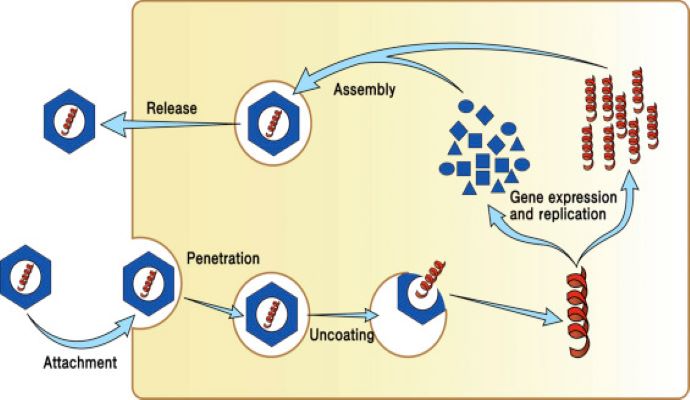
DrAfter123/DigitalVision Vectors
A History of Antivirals: Mechanisms, Classes, and Subtypes
Understanding the history, mechanisms, classes, and subtypes of antivirals may help inform the development and distribution of such drugs.
Antivirals have rapidly become a popular topic with their implications in treating COVID-19. Understanding antivirals, their mechanisms, classes, and subtypes is an essential part of being able to treat viral infections such as the infection by the SARS-CoV-2 virus, which has swept the nation in recent years during the COVID-19 pandemic.
According to a publication in Clinical Microbiology Reviews, there are over 90 antivirals developed and in use to date.
Antivirals target one of the nine following viral infections:
- HIV infections
- hepatitis B virus (HBV) infections
- hepatitis C virus (HCV) infections
- herpesvirus infections
- influenza virus infections
- human cytomegalovirus infections
- varicella-zoster virus infections
- respiratory syncytial virus infections
- external anogenital warts caused by human papillomavirus (HPV) infections
What Is a Virus?
According to the Synthesis of Best-Seller Drugs, “viruses are basically a pack of genetic material — either DNA or RNA — carried in a shell made up of protein.” Standard viral features include nucleic acid, a protein coat, and a lipid membrane.
Viral transmission typically depends on the virus type but can be spread by sharing bodily fluids or animal bites.
The Life Cycle of a Virus
To better understand antivirals, their process, and their benefits, it is crucial to analyze the life cycle of a virus. Based on explanations from Molecular Virology of Human Pathogenic Viruses, the viral life cycle is made up of 6 stages, all of which are shown in the infographic below:
- attachment
- penetration
- uncoating
- gene expression and replication
- assembly
- release

According to this journal, “after entering the cell and localizing to an intracellular milieu, the virus sheds its capsid, transcribes its RNA, translates its RNA to the viral proteins, replicates its genome, assembles the viral components, and finally exits from the cell.”
Different antivirals will target varying parts of this cycle.
What Are Antivirals?
According to the International Society for Influenza and other Respiratory Virus Diseases (ISIRV), “antivirals complement vaccines in combating virus infection. They may have a role in prophylaxis (in addition to vaccines) to prevent infection as well as therapeutically to treat disease.”
History of Antivirals
Antiviral drug development is complex and has taken significantly longer to progress than antibiotic drug development.
“Antiviral chemotherapy has advanced at a snail-like pace, unlike antibiotics, which in 30 years achieved an advanced therapeutic stage,” stated clinicians in an article for Medicina Universitaria.
Early attempts to develop antivirals were futile and included the use of pre-existing antibiotics. In 1957, the discovery of the interferon — a natural substance that helps the immune system fight infection —was a significant milestone in viral therapies. Its discovery led to the development of human interferons used to treat hepatitis B and later hepatitis C.
In 1959, Bill Prusoff discovered idoxuridine, the first antiviral nucleoside analogue. “An important byproduct of this work was the discovery that IDU was a specific inhibitor of certain large DNA viruses, most notably herpes simplex virus (HSV),” wrote the authors of an article in Microbiology Today.
The 1961 discovery of guanidine and 2-(α-hydroxy benzyl)benzimidazole (HBB)’s abilities to inhibit the poliovirus was later used to develop antivirals against the poliovirus.
“Influenza was also an early antiviral target, and in 1964, it was reported by C.E. Hoffmann and co-workers that amantadine was a specific inhibitor of the negative RNA strand virus, influenza A.”
According to an infographic published in Chemical and Engineering News, the first antiviral, idoxuridine, was approved in 1963 for topical treatment of the herpes simplex virus (HSV).
Following this, the first systemic antiviral was approved for the treatment of HSV in 1977.
By 1981 research had developed to create the first selective antiviral, acyclovir, which also targeted HSV and had minimal side effects.
The first HIV antiviral, called azidothymidine, was approved in 1987. Saquinavir, introduced in 1995, was the first protease inhibitor to treat any viral infection. This drug was developed for the treatment of HIV.
In 1999 Tamiflu (chemically known as oseltamivir) and zanamivir were approved for influenza.
One of the most recent antivirals is , used to treat COVID-19.
Types of Antivirals
There are multiple different kinds of antivirals.
Attachment Inhibitors
There are multiple different kinds of antivirals. Attachment inhibitors are direct virus-targeting antivirals. Viral infections begin with the virus binding to the host cell via proteins on the cell’s surface. This class of antivirals prevents this binding from happening.
Entry Inhibitors
Another type of direct virus-targeting antivirals is entry inhibitors. These prevent the virus from entering the host cells. Viruses can either enter the cell via fusion or phagocytosis. One class of entry inhibitors, fusion inhibitors, prevent the conformational changes required for membrane fusion.
Uncoating Inhibitors
The next type of antiviral targets the uncoating phase of the viral life cycle. Uncoating inhibitors prevent capsid disintegration, preventing the virus’ genetic material from being released into the host cell.
Protease Inhibitors
Protease inhibitors prevent viral replication by blocking proteolytic cleavage of protein precursors necessary for producing infectious particles.
Polymerase Inhibitors
Polymerase inhibitors help prevent further gene expression by blocking enzymatic function, thus preventing the virus from multiplying.
Nucleoside and non-nucleoside inhibitors are both types of polymerase inhibitors. Nucleoside inhibitors bind directly to the polymerase’s active site, while non-nucleoside inhibitors bind to the allosteric site. Both of which change the structure of the polymerase, preventing their action.
Nucleoside and Nucleotide Reverse Transcriptase Inhibitors
These types of antivirals are predominantly used for the treatment of HIV. “In triphosphate forms, they compete with their corresponding endogenous deoxynucleoside triphosphates for incorporation by HIV reverse transcriptase. Once incorporated, they serve as chain-terminators of viral reverse transcripts, thus, acting on the viral replication cycle by inhibiting a critical step of proviral DNA synthesis prior to integration into the host cell genome,” stated writers in the Synthesis of Best-Seller Drugs.
Non-nucleoside Reverse-Transcriptase Inhibitors
These types of antivirals are used to treat HIV and AIDS. These reverse transcriptase inhibitors do not compete with nucleoside reverse transcriptase inhibitors as they work at a different site.
Integrase Inhibitors
These drugs prevent the virus’s DNA from being incorporated into the host cell’s DNA by inhibiting integrase enzymes.
Indirect Virus-Targeting Antivirals
There has been some research done on indirect virus-targeting antivirals. Rather than target the actual viral factors, these approaches target cellular factors or pathways that allow for viral replication. While some indirect antivirals prevent intracellular signaling cascades, others block replication and transcription.
Benefits of Antivirals
Antivirals have proved to be a tool in expediting recovery from certain viruses.
A publication in Biochemical Pharmacology states that “antiviral therapy is obviously needed to control those infections that are not amenable to prophylaxis by vaccination but is also highly desirable for those infections where vaccination has not been implemented or did not fulfill its premises for complete protection.”
Despite their benefits, further research needs to be done on antivirals and their development to help improve viral infection treatment.





